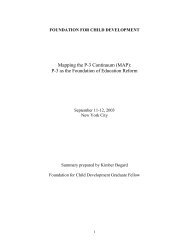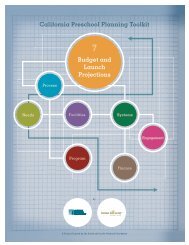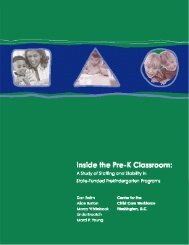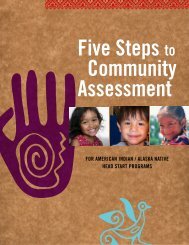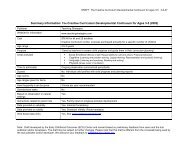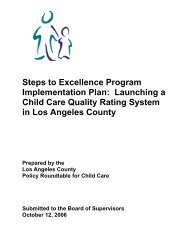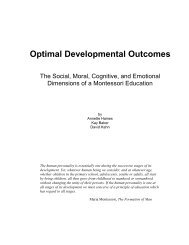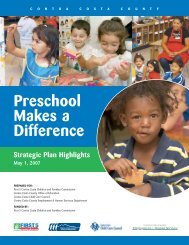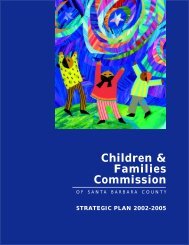FIRST 5 - PGS 1-16R1.cdr - Plan4Preschool
FIRST 5 - PGS 1-16R1.cdr - Plan4Preschool
FIRST 5 - PGS 1-16R1.cdr - Plan4Preschool
Create successful ePaper yourself
Turn your PDF publications into a flip-book with our unique Google optimized e-Paper software.
330 North D Street, 5th Floor<br />
San Bernardino, CA 92415-0442<br />
Tel: (909) 386-7706 • Fax: (909) 386-7703<br />
www.first5sanbernardino.org<br />
Strategic Plan for Our Children<br />
Prenatal Through Age Five
Children & Families Commission<br />
for San Bernardino County<br />
Bill Postmus, Chair<br />
San Bernardino County Supervisor<br />
•<br />
Loren Sanchez, Ed.D, Vice Chairperson<br />
School Superintendent Retired<br />
•<br />
Carol Anselmi<br />
Assistant Administrative Officer for Human Services<br />
•<br />
Sue Ovitt<br />
Championship Management Events Admin<br />
•<br />
Thomas J. Prendergast, Jr., MD<br />
Director of Public Health<br />
•<br />
Elizabeth Thomas<br />
3rd District, Board of Supervisors Field Representative<br />
•<br />
Guillermo Valenzuela, M.D.<br />
San Bernardino County Medical Society<br />
MISSION<br />
Under the guidance of the children and Families<br />
Commision for San Bernardino, and in collaboration with<br />
the community and agencies providing<br />
services to children.<br />
First 5 San Bernardino will promote,<br />
support and enhance the early<br />
development of our children prenatal<br />
through age five.<br />
through a needs based, family centered, culturally<br />
appropriate, accessible and integrated services delivery<br />
system with well-defined and meaningful outcomes,<br />
so that . . .<br />
All children enjoy optimal physical,<br />
cognitive, emotional and social well-being.
Strategic Partners<br />
Asuncion Abbott Ace Acevedo Kay Adkins Carol Baker Dora Barilla Jeannette Belton<br />
Leslie Bramson Katharine Braun Melissa Brenneman Norm Brinkley Dave Brown Elena Carrasco<br />
Socorro Castanon Dr. Lony Castro Cathy Cimbalo Stephani Congdon Michele Cook Denise Cummins<br />
Lawrence Dale Frank Davenport Sherril D'Espyne Heather Diaz Norm Dollar Sandra Doyle<br />
Linda Drew Dr. David Dyjack Heidi Earls Dr. Rick Eberst<br />
Ed Eddingfield Sharon Eddingfield Larry Enriquez Sharon Erdmann<br />
Gisela Erne Dr. Herb Fischer Dr. Steve Fisher Monica Floyd<br />
Special thanks to . . .<br />
Wade Forde Karen Fosdick Joyce Frevert Dr. Eric Frykman<br />
Chico Garza Celia Gaston Pamela George Margaret Gooding<br />
Kaplan & Associates<br />
Steve Kaplan<br />
Nell Gory Ron Griffin Cindy Hall John Hams Sandy Hardie<br />
Loma Linda University,<br />
Walter Hawkins Lt. Ted Hensen June Hibbard Eileen Hofer<br />
School of Public Health<br />
Debra Holder Cathy Holguin Rebekah Holkesvig Susan Jennings<br />
Kriston Jensen Viatrice Jews Janel Johnson Dr. Laura Kamptner<br />
Stephen Kaplan Dr. Michael Karpman Tricia Kendrick<br />
Heather Diaz, MPH<br />
Julie Pham, MPHc<br />
Redlands Institute<br />
Melissa Brenneman<br />
Dr. Michele Kipke Bonnie Konowitch Steve Kurz Dana Larrison<br />
Frank Davenport<br />
John Lewis Joyce Lewis Dr. Joyce Lim Lt. Al Long Rudy Lopez<br />
First 5 San Bernardino<br />
Tara Lopez Juliette Lynch Kathie Martin Rebecca Martin<br />
Linda Angona<br />
Renee Marquez Joseph Matoush Lorraine MacCaulay<br />
Pattie McGinty Dr. John Meier Heather Menninger-Meyeda<br />
Laura Messmore Annie Miller Monicka Montanez Dr. Susanne Montgomery<br />
Tony Mueller Angelia Myles Vici Nagel Jeanne Newcomer Linda Niemeyer Shirley Northcutt-Thomas<br />
Jeannette Oehrlein Lorraine Ousley Patty Pate Kim Patrick Pha Patrick Kent Paxton Jackie Peebles<br />
Bernie Pellman Tanya Perry Valarie Peterson Julie Pham Faye Pointer Dr. Aylene Popka Dee Price<br />
Kathy Quiroga Jennifer Resch-Silvestri Dr. David Rogers Sharon Rogone Glenn Salas Rasmey Sam<br />
Lorretta Schnaus Olivia Sevilla Saul Silva Sharon Smith Claudia Spencer Mary Sypkens<br />
Dr. Bruce Smith Sharon Smith Leslie O'Hare Sorensen Jane Stultz Pat Talley Kim Takaoka<br />
Lisa Thiele Melissa Thompson Dr. Nena Torrez Evelyn Trevino Michelle Turpin<br />
America ValleMarilyn Vecchio Cristina Vergara Wytske Visser Jeff Wagner Julie Wartell<br />
Jeff Waters Sandra Waters Regina Weatherspoon-Bell Dr. Elliott Weinstein Penny Weiss<br />
Debra Anne Williams Jan Williams Susan Willis Dr. Sam Wilson Kathryn Wood Roberta York<br />
Susan Zimarik Karen Zukrow<br />
Susanne Montgomery, PhD, MPH<br />
First 5 San Bernardino: Linda Angona Delia Barretto<br />
Sandra Bethea Elena Carrasco Kariya Glasglow<br />
Darla Goodrum Ruth Griffin Nancy Hubbard Stacy Iverson<br />
Mary Jaquish Linda Kelly Crystal Kennedy Don Larkin<br />
Dorcus McCrary Angelia Myles Regina Prentice<br />
Joann Roberts Kathie Ruiz Edmund Sarpong<br />
Elaine Zucco<br />
Along with the voices and ideas<br />
of hundreds of other individuals<br />
representing our diverse county,<br />
we joined together in<br />
developing ...<br />
16
“If<br />
income is<br />
limited,<br />
families are<br />
often forced to<br />
make a choice<br />
between<br />
childcare and<br />
putting food on<br />
your table.”<br />
Parent of special needs child<br />
Strategic Planning,<br />
Strategic Action,<br />
Strategic Impact!<br />
OUR FUTURE =<br />
OUR CHILDREN<br />
Now, more than ever, we know that the emotional,<br />
physical, and intellectual world a child experiences<br />
during the first five years of life greatly influences his<br />
or her development and chances for future success.<br />
Determined to give all our children a better future,<br />
First 5 San Bernardino, in collaboration with its<br />
community partners, has revised its Strategic Plan to<br />
better promote, support, and enhance the early<br />
development of children prenatal through age five.<br />
THE BEGINNING<br />
The work of First 5 San Bernardino began with the<br />
passage of The California Children and Families Act<br />
of 1998, through Proposition 10. The Act established a<br />
focus on the critically influential period from prenatal<br />
through age five of a child's life. On December 15,<br />
1998, the County Board of Supervisors created the<br />
Children and Families Commission for San<br />
Bernardino County and charged it with the<br />
responsibility for developing and implementing a<br />
program in our county.<br />
To fund the program, revenue was<br />
generated by a fifty-cent per pack tax on<br />
the sale of cigarettes and other tobacco<br />
products. This money has been<br />
allocated to each of California's 58<br />
counties based on the number of live<br />
births annually. San Bernardino County<br />
will receive approximately $24 million<br />
during Program Year 2003-2004 to<br />
provide these much needed services for<br />
our children.<br />
The Children and Families<br />
Commission for San Bernardino<br />
County adopted its initial Strategic Plan<br />
in April 2000. The plan specified many<br />
of the challenges faced by our children,<br />
prenatal through age five, and their<br />
families.<br />
Just as with a child, the first years of<br />
implementation proved formative for<br />
First 5 San Bernardino. Through four<br />
years of experience in providing services,<br />
building a stable infrastructure, and<br />
increasing program and administrative<br />
effectiveness, we have begun to realize<br />
the potential that the future holds. Most<br />
importantly, many new alliances have been<br />
made through an expanding network of<br />
organizations and individuals who share<br />
concern about the well-being of children<br />
and their families.<br />
As the program has developed, the world<br />
around us has changed. Revenue from the<br />
Proposition 10 tobacco tax is decreasing;<br />
the state has been impacted negatively by a<br />
budget crisis; and the county's population<br />
and diversity and its need for more services<br />
have continued to grow.<br />
2 3
In other words, where and to what extent are<br />
services most needed, and what positive changes<br />
in the conditions of children and families will we see<br />
as a direct result of our efforts?<br />
A far-reaching, inclusive and continuing planning<br />
process was developed, recognizing the<br />
importance of the geographic, economic, ethnic and<br />
cultural diversity of our county. The process relied<br />
heavily on input from the following key participatory<br />
groups:<br />
• a Technical Advisory Team comprised of<br />
experts in child development related fields;<br />
• six Community Advisory Teams from six<br />
regional planning areas, reflecting the diversity<br />
of the community; and<br />
We now have a better understanding of the<br />
challenges facing families with young children, the<br />
capacities and capabilities of providers of health, child<br />
development, and family support services, and the<br />
potential for vital community support.<br />
It has become abundantly clear, however, that we<br />
need to either access or create additional sources of<br />
information that will better define the needs of children<br />
and families throughout our huge county.<br />
The Commission, with its community<br />
partners, will work toward enhancing<br />
data gathering and analyzing capabilities<br />
over the next several years.<br />
“…parents<br />
are the role<br />
models, setting<br />
examples of<br />
what (children)<br />
should be, as<br />
far as adults<br />
growing up,<br />
taking care of<br />
responsibilities..”<br />
Parent of two children<br />
PARTNERING WITH<br />
OUR COMMUNITY<br />
Our community is growing rapidly. At<br />
present there are 184,802 children prenatal<br />
through age five in the County, comprising<br />
about 10% of the total population, and their<br />
numbers and needs are increasing.<br />
The Commission, in response to the<br />
challenges and opportunities confronting<br />
our children, called for a thorough,<br />
inclusive review of its Strategic Plan in<br />
order to better define their needs, and to<br />
ensure that First 5 San Bernardino's<br />
programs have an impact.<br />
• an Integration Committee made up of parents,<br />
content experts, community members,<br />
organizational leaders and advocates.<br />
More than 150 dedicated San Bernardino County<br />
residents participated on the above teams, and<br />
over 1,200 concerned citizens and parents provided<br />
additional input through surveys, interviews, focus<br />
groups and community forums. Their valuable<br />
contributions greatly assisted the Commission in<br />
identifying and prioritizing desired results and<br />
strategies for achieving them.<br />
4 5
• We strive to deliver services that have been<br />
proven to be effective and are outcome<br />
based.<br />
• We work with our partners to ensure that we<br />
use our resources in the most efficient ways<br />
possible.<br />
• We will adhere to a continuous cycle of<br />
planning in order to be responsive to<br />
emerging needs and populations.<br />
OBJECTIVES<br />
To further define the intent of each desired result,<br />
objectives were created relating to each result. By<br />
establishing measurable objectives, we can identify<br />
specific strategies that improve the likelihood of<br />
success and measure progress to support continual<br />
improvement and accountability.<br />
“First that there<br />
are doctors<br />
that speak our<br />
language so<br />
that they can<br />
explain to us<br />
and so that they<br />
can understand<br />
when we tell<br />
them what is<br />
wrong with our<br />
children.”<br />
Spanish-speaking parent<br />
of small children<br />
GUIDING PRINCIPLES<br />
During the planning process, we adhered to<br />
the following values and will continue to be<br />
guided by them:<br />
• We are committed to all children<br />
prenatal through five years of age and<br />
their families, and are focused on<br />
those children and families at greater<br />
risk.<br />
• We are dedicated to building a strong<br />
foundation based on early<br />
development and the prevention of<br />
potentially adverse outcomes.<br />
• We seek the involvement of our<br />
community in planning, service<br />
delivery, and assessment.<br />
• We view the cultural diversity of the<br />
community, the children and families,<br />
and our staff as an indispensable<br />
asset to our work.<br />
• We will ensure that children and families are<br />
served as part of an integrated system of<br />
collaborative partners.<br />
DESIRED RESULTS<br />
The vision commands our strategic direction. Our<br />
plan subscribes to the belief that, in order to realize<br />
substantial progress over time, attention must be<br />
focused on the child, the family and the<br />
effectiveness of the delivery of services.<br />
Desired results are the changes First 5 San<br />
Bernardino wants to accomplish over several years.<br />
All activities will help us move toward achieving one<br />
or more of the following desired results:<br />
• Children are safe and healthy.<br />
• Children are learning and ready to enter and<br />
succeed in school.<br />
• Families are safe, healthy, nurturing, and<br />
self-sustaining.<br />
• Systems are responsive to the needs of<br />
children, families, and communities.<br />
The Commission's policies, programs and<br />
allocation of resources will align with the vision and<br />
link to one or more of these supporting results.<br />
VISION<br />
MISSION<br />
A mission is an organization's statement of purpose. Our<br />
mission, written from a collective desire to capture the<br />
essence of First 5 San Bernardino's charge, is:<br />
First 5 San Bernardino will promote,<br />
support, and enhance the early<br />
development of our children<br />
prenatal through<br />
age five.<br />
A vision represents an organization's loftiest<br />
aspiration. The Children and Families Commission for<br />
San Bernardino County, through First 5 San Bernardino,<br />
joins with the community in a commitment to the<br />
following vision:<br />
All children enjoy optimal physical,<br />
cognitive, emotional and<br />
social well-being.<br />
6<br />
7
Team members worked diligently for over nine<br />
months to develop the priority needs of our youngest<br />
residents. The multitude of needs identified reinforced<br />
the philosophy that Commission and countywide<br />
collaboration is critical to the achievement of our<br />
desired results. The Commission recognized that<br />
tough choices would have to be made as to where to<br />
target resources to ensure the broadest reach with<br />
the greatest impact. Identified needs were<br />
categorized, prioritized, and aligned to the desired<br />
results. The Commission used systematic criteria for<br />
prioritizing the needs, which included items such as<br />
size of need, severity of need, and potential to<br />
achieve a significant impact.<br />
Integration Team members also identified prospective<br />
partners who may have the capacity and interest to<br />
collaborate with First 5 San Bernardino in<br />
implementing each strategy. Every effort will be made<br />
to engage these partners to achieve high levels of<br />
efficiency, maximize available resources, and create<br />
opportunities for the future.<br />
The priority strategies focus on four areas: System<br />
Integration, Child Development, Family Support, and<br />
Health and Well-Being. The graph on the next page<br />
displays the relationships between the strategies and<br />
the objectives they address.<br />
Priority Strategies<br />
Each strategy addresses one or more<br />
objectives in the plan. Priority strategies<br />
have been identified as those that will be<br />
implemented first and will continue over<br />
the next few years to achieve the<br />
desired results. Supplemental strategies<br />
will be implemented as resources and<br />
time permit.<br />
“Sometimes, I<br />
wonder, do our<br />
parents have<br />
enough skills<br />
within themselves<br />
to realize how<br />
vital (child health)<br />
is?”<br />
Speech clinician<br />
GETTING TO KNOW<br />
OUR COMMUNITY ...<br />
Making Critical Choices<br />
The vast and diverse needs of the children<br />
and families of our county quickly surfaced<br />
as the planning process unfolded. Through<br />
extensive analysis by Community Advisory<br />
and Integration Team members, a multitude<br />
of needs for our children and their families<br />
were identified and prioritized. Team<br />
members relied on their own knowledge<br />
and expertise as well as the qualitative data<br />
results from parent surveys, focus groups,<br />
key informant interviews and community<br />
forums to make key recommendations.<br />
PRIORITY NEEDS<br />
• Children negatively impacted by substance abuse,<br />
child abuse, and domestic violence<br />
• The need for parent education<br />
• The need for high quality, affordable early<br />
education programs<br />
• The importance of prenatal care<br />
• The need to increase screening/identification of<br />
special needs children<br />
• Access to and isolation from services in many<br />
areas<br />
• Improving and caring for parental health (physical<br />
and mental)<br />
• The need for more play spaces<br />
STRATEGIES<br />
Once the intensive work of establishing the desired<br />
results and needs was conducted, the Community<br />
Advisory Teams proposed ways to address the needs<br />
in each community. Team members used a number of<br />
resources and levels of expertise to assist in identifying<br />
the most effective strategies for their communities. The<br />
strategies were then reviewed and analyzed by the<br />
Integration Team from a countywide perspective.<br />
8 9
Priority Strategies<br />
Child and Family Assessment<br />
Implement standardized developmental assessment<br />
tools to be used during pregnancy, at birth, and during early childhood.<br />
Health Care Access<br />
Child Care Advocacy<br />
Advocate for additional State and Federal support<br />
to increase number of child care providers.<br />
Resource Centers<br />
Expand and create family resource<br />
centers customized to local needs.<br />
Objectives<br />
1 2 3 5 8 10 11<br />
Improve access to comprehensive health services. 1 2 3 8 10 11 12<br />
6 7<br />
2 3 4 7 8 12<br />
12<br />
Children<br />
Are Safe<br />
And Healthy<br />
Vision<br />
All children enjoy<br />
optimal physical, cognitive,<br />
emotional and social well-being<br />
Desired Results<br />
Children Are<br />
Ready To Enter<br />
And Succeed<br />
In School<br />
Families Are<br />
Safe, Healthy,<br />
Nuturing And<br />
Self-Sustaining<br />
Systems Are<br />
Responsive To<br />
The Needs Of<br />
Children, Families<br />
and Community<br />
“…a lot of<br />
times we do not<br />
have the<br />
education to be<br />
able to<br />
help…we are<br />
afraid to go<br />
near clinics<br />
and precisely<br />
because of the<br />
lack of<br />
education.”<br />
Spanish-speaking parent<br />
Parenting Education<br />
Implement accessible parent education based on<br />
proven practices.<br />
Sharing Information<br />
Share data between service agencies for the<br />
benefit of the child.<br />
2 3 4 7 8 12<br />
12 13<br />
1<br />
Children are<br />
born healthy<br />
Children live<br />
in a home<br />
Objectives<br />
environment<br />
4 8<br />
supportive of<br />
learning<br />
Parents are<br />
mentally and<br />
physically fit<br />
12<br />
Systems<br />
support<br />
families<br />
System Integration Advocacy<br />
Adopt a system integration policy.<br />
12 14 15<br />
2<br />
Children are<br />
healthy, wellnourished<br />
and<br />
physically fit<br />
5<br />
Children receiving<br />
early screening<br />
and intervention<br />
for special needs<br />
9<br />
Parents practice<br />
developmentally<br />
appropriate<br />
parenting skills<br />
13<br />
Systems<br />
are results<br />
based<br />
System Access<br />
Develop an information and referral system.<br />
Community Education<br />
Develop a community education campaign to<br />
1 2 3 4 5 56 7 8<br />
promote early childhood development. 9 10 11 12 13 14 15 16<br />
Technical Assistance<br />
Provide technical assistance to improve the<br />
capacity and ability of agencies serving children.<br />
12 14 15<br />
1<br />
9<br />
2<br />
3<br />
4<br />
5 56<br />
10 11 12 13 14<br />
7 8<br />
15<br />
16<br />
3<br />
Children are<br />
raised in safe<br />
and nurturing<br />
environments<br />
6<br />
7<br />
Children have<br />
access to high<br />
quality early<br />
childhood<br />
development<br />
programs<br />
Children<br />
develop within<br />
normal ranges<br />
in all domains<br />
10<br />
11<br />
Children are<br />
free from any<br />
form of<br />
abuse<br />
Families are<br />
stable and have<br />
the capacity to<br />
meet the needs<br />
of their children<br />
14<br />
15<br />
Community<br />
has access<br />
to services<br />
Families, providers,<br />
and stakeholders<br />
collaborate on the<br />
well being of the<br />
child<br />
16<br />
System sustains<br />
programs and<br />
services that<br />
achieve desired<br />
results<br />
10 11
Supplemental Strategies<br />
Health Care Quality<br />
Strategies will be phased in incrementally,<br />
with each subsequent strategy building<br />
upon the successful implementation of the<br />
previous one.<br />
Competitive, non-competitive, collaborative<br />
partnerships, and expansion or extension<br />
of programs using proven techniques will<br />
be among the methods of procurement.<br />
Supplemental strategies will be<br />
implemented as resources and time permit.<br />
Promote medical practices with proven results. 1<br />
Prenatal and Pediatric Care Availability<br />
Objectives<br />
Advocate for additional birthing and pediatric medical services. 2 5 7<br />
RESOURCE ALLOCATIONS<br />
The Commission has established a preliminary plan<br />
for distributing funds to support each of the adopted<br />
strategies. The percentages listed below are meant<br />
to guide the implementation process. However, the<br />
actual dollars allocated may be influenced by<br />
unanticipated circumstances that develop during<br />
the course of this plan.<br />
• System Integration - 20%, plus one-time costs<br />
funded from the reserves<br />
• Child Development - 25%<br />
• Family Support - 30%<br />
• Health and Well-being - 25%<br />
Allocation of resources will be needs based and<br />
data driven as determined by the needs<br />
assessment and will not be<br />
guided by geo-political<br />
boundaries.<br />
To promote the concepts of collaboration<br />
and leveraging, First 5 San Bernardino<br />
funds may not be the sole funding source<br />
for any program or provider. Specifically,<br />
matching funds or documented in-kind<br />
funding specific to the project will be<br />
required.<br />
The intent of First 5 San Bernardino is to<br />
make long-term investments, when<br />
appropriate, in the services and programs<br />
that are achieving positive outcomes. Over<br />
time, those services will be required to<br />
obtain assistance from sources other than<br />
First 5 San Bernardino in order to support<br />
their sustainability.<br />
Child Care Quality Standards<br />
Establish standards for quality child care based on proven practices<br />
and assist with accreditation.<br />
6<br />
7<br />
Child Care Capacity<br />
Provide technical assistance for prospective child care providers in obtaining<br />
licensing and certification, and achieving high standards of quality.<br />
6<br />
“To be<br />
honest with<br />
you, I don't<br />
know (what<br />
services are<br />
offered in this<br />
region).”<br />
Mother of two children<br />
Child Care Access<br />
Expand existing financial support to nclude more families and<br />
develop incentives to create slots for children with special needs.<br />
Play Spaces for Children<br />
Provide technical assistance and matching funds to create<br />
more play spaces.<br />
6<br />
2<br />
7<br />
7<br />
12 13
“If you don't<br />
have healthy<br />
parents, you<br />
don't have<br />
healthy children.”<br />
Service provider<br />
EVALUATION<br />
Evaluation is critical to the strategic planning<br />
process because it is the vehicle through<br />
which we track progress, measure impact<br />
and identify the most effective approaches<br />
for achieving the desired results. The Plan's<br />
evaluation component is a reflection of and<br />
builds upon the work completed by the<br />
Technical Advisory Team and First 5 San<br />
Bernardino staff. The approach ensures a<br />
comprehensive, multi-faceted, and<br />
collaborative process. We are committed<br />
to documenting program and participant<br />
outcomes as well as examining<br />
community-wide impact through an array<br />
of data collection methods.<br />
As we move forward, our partners will<br />
include advisory committee members,<br />
community experts and service providers.<br />
The evaluation is designed to answer the<br />
following questions:<br />
• How many unduplicated families,<br />
children and service providers<br />
participated in programs?<br />
• Do children ages 0-5 who participate<br />
in First 5 San Bernardino activities<br />
demonstrate improvement in<br />
indicators of well being?<br />
• What outcomes have service agencies<br />
and their participants achieved?<br />
• Which implementation strategies are<br />
supported as best practices?<br />
• Are systems of care to families of<br />
young children more integrated and<br />
coordinated?<br />
• What needs of families and children<br />
were identified that will need to be<br />
addressed in the ongoing strategic<br />
planning process?<br />
• What impact has First 5 San<br />
Bernardino had on community-wide<br />
indicators of well-being?<br />
These questions demand both immediate and longterm<br />
tracking of the plan's impact in our community.<br />
Evaluation planning must respond to change as the<br />
strategies are implemented. Because the needs of<br />
children, families and communities change, First 5<br />
San Bernardino will conduct an annual review of its<br />
strategic plan with a three to five year look ahead<br />
every year.<br />
Environmental factors, changes in demographics, the<br />
effectiveness and efficiency of services, and resource<br />
availability, among other things, will be considered. An<br />
advisory committee comprised of technical experts<br />
and community representatives will provide the<br />
professional and community input essential to making<br />
this happen.<br />
LOOKING<br />
TO OUR FUTURE<br />
This Strategic Plan is designed to help<br />
our children thrive. It took hundreds of<br />
people to create this plan, and it will take<br />
thousands more to make it a reality.<br />
What resources, financial and otherwise,<br />
can you contribute? We invite you to join<br />
with our family of agencies, services, and<br />
individuals working together to give all<br />
children a brighter future.<br />
Armed with the knowledge that the first five<br />
years of a child's life greatly influence his or<br />
her development and chances for future<br />
success, isn't it our collective need,<br />
responsibility, and reward to do so?<br />
14 15



